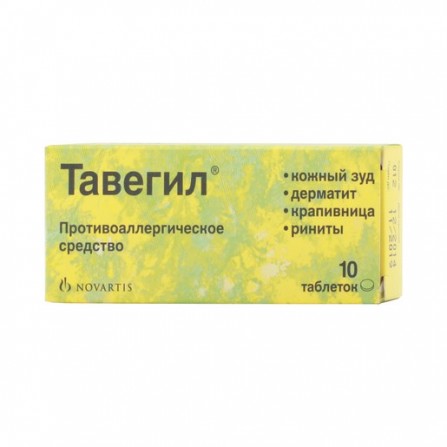More info
Active ingredients
Clemastine
Release form
Pills
Composition
Clemastine hydrofumarate 1.34 mg 2.68 mg, which corresponds to the content of clemastin 1 mg 2 mg. Auxiliary substances: sorbitol - 90 mg, ethanol 96% - 140 mg, propylene glycol - 600 mg, sodium citrate dihydrate - to pH 6.3, water d / and - to 2 ml.
Pharmacological effect
Histamine H1 receptor blocker, an ethanolamine derivative. It has a strong antihistaminic and antipruritic effect with rapid onset of action and a duration of 12 hours, prevents the development of vasodilation and smooth muscle contraction, induced gistaminom.Obladaya antiallergic action, reduces the permeability of blood vessels, capillaries, inhibits exudation and edema formation, reduces itching, has m-anticholinergic Effect.
Pharmacokinetics
AbsorptionAfter ingestion, clemastine is almost completely absorbed from the gastrointestinal tract. Cmax in plasma is reached in 2-4 hours. Distribution Clemastin binding to plasma proteins is 95%. It is excreted in breastmilk in an insignificant amount. Metabolism and excretion. Excretion from plasma has a two-phase character, the corresponding T1 / 2 is 3.6 ± 0.9 h and 37 ± 16 h. Clemastin undergoes a significant metabolism in the liver. Metabolites are mainly (45-65%) excreted in the urine; unchanged active substance is found in urine only in trace amounts.
Indications
- pollinosis (hay fever, including allergic rhinoconjunctivitis); - urticaria of different origin; - itching, itchy dermatosis; - acute and chronic eczema, contact dermatitis; - drug allergy; - insect bites.
Contraindications
- diseases of the lower respiratory tract (including bronchial asthma); - simultaneous use of MAO inhibitors; - children up to 6 years; - pregnancy; - lactation (breastfeeding); - hypersensitivity to the components of the drug. Tavegil; in patients with stenosing gastric ulcer, with pyloroduodenal obstruction, with bladder neck obstruction, and prostatic hypertrophy, accompanied by urinary retention, with increased intraocular pressure, hyperthyroidism, and diseases of the cardiovascular system (including arterial hypertension).
Precautionary measures
Use in children Contraindications: children under the age of 1 year (pills should not be used in children under the age of 6 years).
Use during pregnancy and lactation
Use of the drug Tavegil is contraindicated; during pregnancy and lactation (breastfeeding).
Dosage and administration
Inside adults and children older than 12 years, appoint 1 tab. (1 mg) in the morning and in the evening. In cases difficult to treat, the daily dose may be up to 6 tab. (6 mg). Children at the age of 6-12 years old are prescribed 1 / 2-1 tab. before breakfast and for the night. Tablets should be taken before meals with water.
Side effects
Determination of the frequency of adverse reactions: very often (≥1 / 10); often (≥1 / 100, <1/10); infrequently (≥1 / 1000, <1/100); rarely (≥1 / 10,000, <1/1000); very rarely (<1/10 000). From the nervous system: often - increased fatigue, drowsiness, sedation, weakness, fatigue, lethargy, loss of coordination of movements; infrequently - dizziness; seldom - headache, tremor, stimulating effect. From the digestive system: rarely - dyspepsia, nausea, vomiting, gastralgia; very rarely - constipation, dry mouth; in some cases - loss of appetite, diarrhea. From the respiratory system: rarely - thickening of bronchial secretions and difficulty in sputum separation, feeling of pressure in the chest and difficulty breathing, nasal congestion. From the side of the cardiovascular system: rarely - lowering blood pressure (most elderly patients), extrasystole; very rarely - heartbeat. From the sense organs: rarely - impaired clarity of visual perception, diplopia, acute labyrinthitis, tinnitus. From the urinary system: very rarely - frequent urination, difficulty urinating. thrombocytopenia, agranulocytosis. Dermatological reactions: rarely - skin rash, photosensitization. Allergic reactions: rarely - anaphylactic shock.
Overdose
Symptoms: An overdose of antihistamines can lead to both depressing and stimulating effects on the central nervous system. CNS stimulation is more common in children. Manifestations of anticholinergic action may also develop: dry mouth, fixed pupil dilation, rush of blood to the upper half of the body, gastrointestinal disorders (nausea, epigastric pain, vomiting). Treatment: if a patient does not vomit spontaneously, then it should be called artificially (only if the patient’s mind is preserved).If 3 hours or a little more has passed since taking the drug, you can wash the stomach with an isotonic solution of sodium chloride. You can also prescribe a saline laxative. Symptomatic therapy is also indicated.
Interaction with other drugs
Tavegil; potentiates the action of drugs that depress the central nervous system (hypnotics, sedatives, tranquilizers), m-cholinoblockers, and ethanol. Incompatible with simultaneous administration of MAO inhibitors.
special instructions
To prevent distortion of the results of skin scarification tests for allergens, the drug should be canceled 72 hours before the allergic testing. The pills contain lactose, so the drug is not recommended for patients suffering from rare congenital diseases associated with intolerance to galactose, severe lactase deficiency and glucose absorption galactose. Use in pediatricsTavegil; in tablet form is contraindicated in children under the age of 6 years. Tavegil can be used to treat children from 1 year old; in the form of a solution for intravenous and intravenous infusion. Influence on the ability to drive vehicles and control mechanismsKlemastin has a slight sedative effect (from weak to moderate in intensity), therefore patients, patients taking Tavegil; are advised to refrain from driving vehicles , working with mechanisms, as well as from other activities that require increased attention and speed of psychomotor reactions.





